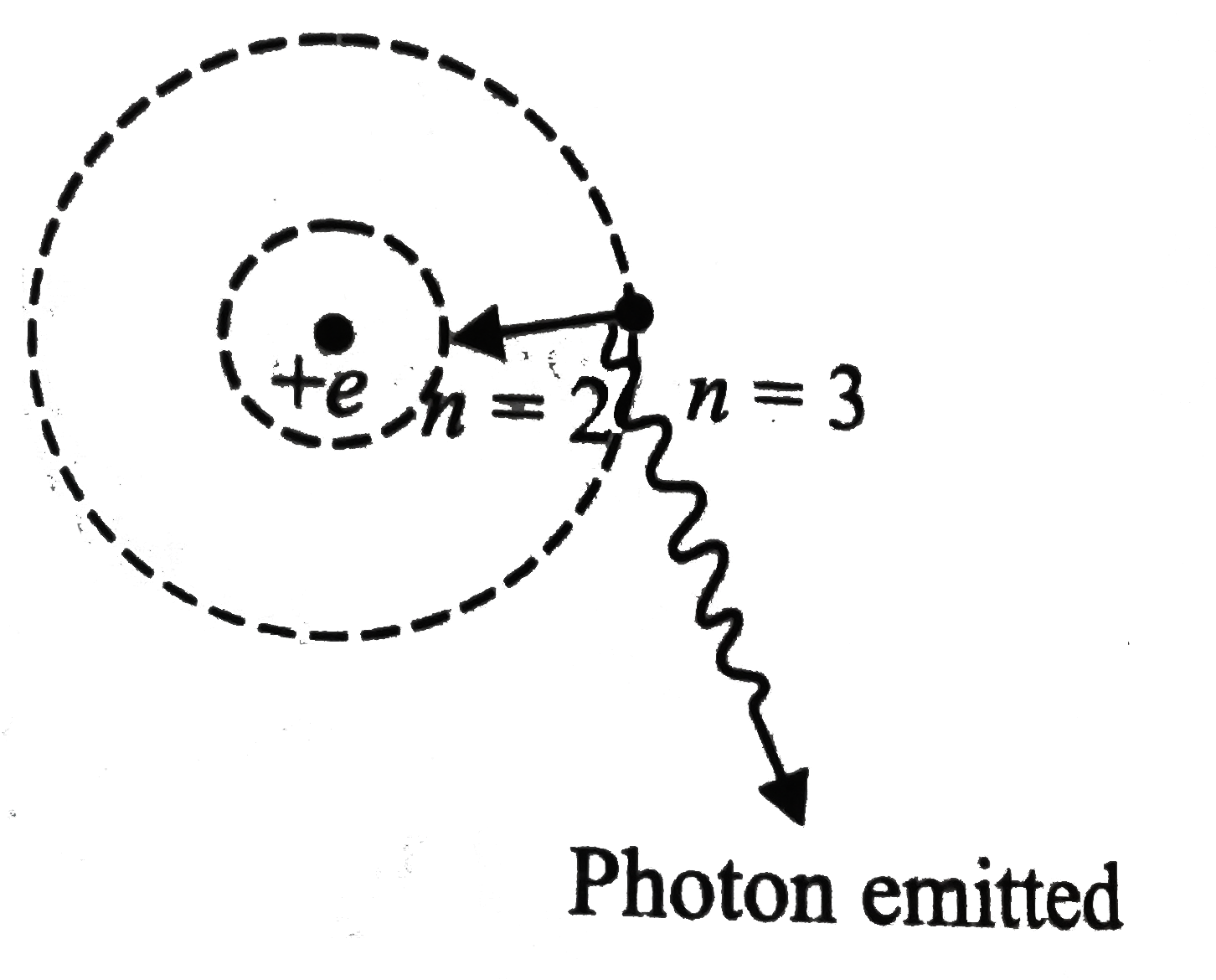A single electron orbits around a stationary nucleus of charge +Ze, where Z is a constant and e is the electronic charge. It requires 47.2eV to excited the electron from the second Bohr orbit to the third Bohr orbit. Find (i) the value of Z, (ii) the energy required to excite the electron from the third to the fourth Bohr orbit and (iii) the wavelength of the electromagnetic radiation radiation to remove the electron from the first Bohr orbit to infinity.
The correct Answer is:5 (b) 16.53 eV (c) 36493.76×10−12m (d) 1.05×10−13'js (e) 0.106×10−10m
To solve the problem step by step, we will break it down into three parts as mentioned in the question.
Step 1: Finding the value of Z
1. Understanding the energy difference: The energy required to excite the electron from the second orbit (n=2) to the third orbit (n=3) is given as 47.2 eV. According to the Bohr model, the energy of an electron in the nth orbit is given by:
En=−Z2⋅13.6eVn2
Therefore, the energy difference between the third and second orbits can be expressed as:
E3−E2=−Z2⋅13.632−(−Z2⋅13.622)
Simplifying this gives:
E3−E2=Z2⋅13.6(122−132)
2. Calculating the energy difference:
E3−E2=Z2⋅13.6(14−19)=Z2⋅13.6(9−436)=Z2⋅13.6⋅536
Setting this equal to 47.2 eV:
Z2⋅13.6⋅536=47.2
3. Solving for Z:
Z2=47.2⋅3613.6⋅5
Z2=1699.268=24.97
Taking the square root:
Z≈5
Step 2: Finding the energy required to excite the electron from the third to the fourth orbit
1. Energy difference from n=3 to n=4:
E4−E3=Z2⋅13.6(132−142)
E4−E3=Z2⋅13.6(19−116)
2. Calculating the energy difference:
E4−E3=Z2⋅13.6(16−9144)=Z2⋅13.6⋅7144
Substituting Z=5:
E4−E3=52⋅13.6⋅7144=25⋅13.6⋅7144
E4−E3=25⋅13.6⋅7144≈16.53eV
Step 3: Finding the wavelength of the electromagnetic radiation to remove the electron from the first Bohr orbit to infinity
1. Energy from n=1 to infinity:
E∞−E1=Z2⋅13.6(112−1∞2)=Z2⋅13.6
Substituting Z=5:
E∞−E1=52⋅13.6=25⋅13.6=340eV
2. Finding the wavelength:
Using the relation E=hcλ:
λ=hcE
Where h=6.63×10−34Js and c=3×108m/s:
λ=6.63×10−34⋅3×108340⋅1.6×10−19
Converting eV to Joules (1 eV = 1.6×10−19 J):
λ≈36.5Angstroms
Summary of Results:
(i) Z=5
(ii) Energy required from n=3 to n=4 is approximately 16.53eV
(iii) Wavelength to remove the electron from n=1 to infinity is approximately 36.5Angstroms
En=−Z2⋅13.6eVn2
Therefore, the energy difference between the third and second orbits can be expressed as:
E3−E2=−Z2⋅13.632−(−Z2⋅13.622)
Simplifying this gives:
E3−E2=Z2⋅13.6(122−132)
E3−E2=Z2⋅13.6(14−19)=Z2⋅13.6(9−436)=Z2⋅13.6⋅536
Setting this equal to 47.2 eV:
Z2⋅13.6⋅536=47.2
Z2=47.2⋅3613.6⋅5
Z2=1699.268=24.97
Taking the square root:
Z≈5
E4−E3=Z2⋅13.6(132−142)
E4−E3=Z2⋅13.6(19−116)
E4−E3=Z2⋅13.6(16−9144)=Z2⋅13.6⋅7144
Substituting Z=5:
E4−E3=52⋅13.6⋅7144=25⋅13.6⋅7144
E4−E3=25⋅13.6⋅7144≈16.53eV
E∞−E1=Z2⋅13.6(112−1∞2)=Z2⋅13.6
Substituting Z=5:
E∞−E1=52⋅13.6=25⋅13.6=340eV
Using the relation E=hcλ:
λ=hcE
Where h=6.63×10−34Js and c=3×108m/s:
λ=6.63×10−34⋅3×108340⋅1.6×10−19
Converting eV to Joules (1 eV = 1.6×10−19 J):
λ≈36.5Angstroms
(i) Z=5
(ii) Energy required from n=3 to n=4 is approximately 16.53eV
(iii) Wavelength to remove the electron from n=1 to infinity is approximately 36.5Angstroms
Similar Questions
A single electron orbit around a stationary nucleus of charge +Ze where Z is a constant and e is the magnitude of the electronic charge. It requires47.2eV to excite the electron from the second bohr orbit to the third bohr orbit. Find
(i) The value of Z
(ii) The energy required by nucleus to excite the electron from the third to the fourth bohr orbit
(iii) The wavelength of the electronmagnetic radiation required to remove the electron from the first bohr orbit to inlinity
(iv) The energy potential energy potential energy and the angular momentum of the electron in the first bohr orbit
(v) The radius of the first bohr orbit (The ionization energy of hydrogen atom =13.6eV bohr radius =5.3×10−11matre velocity of light =3×108m/sec planks 's constant =6.6×10−34 jules - sec )
View SolutionA single electron orbits around a stationary nucless of charge +Ze where Z is a constant and e is the magnitude of electronic charge ,if respuires 47.2 e

is excite the electron from the second bohr orbit to the third bohr orbit
a. Find the value of Z
View Solution
Knowledge Check
The de-Broglie wavelength of an electron in the first Bohr orbit is
Aequal to one- fourth the circumference of the first orbitBequal to half the circumference of first orbitCequal to twice the circumference of first orbit.Dequal to the circumference of the first orbit.
A single electron orbits a stationary nucleus of charge +Ze, where Z is a constant and e is the magnitude of electronic charge . It requires 47.2eV to excite electron from second Bohr orbit to third Bhor orbit . Find
a the value of Z
b the energy required to excite the electron from the third to the fourth Bohr orbit.
c. the wavelength of electromagnetic rediation required to remove the electron from the first Bohr orbit to infinity.
d Find the KE,PE, and angular momentum of electron in the first Bohr orbit.
e. the redius of the first Bohr orbit
[The ionization energy of hydrogen atom =13.6eV Bohr radius =5.3×10_11m, "velocity of light" =3×10−8jms−1, Planck's constant =6.6×10−34j−s]
View SolutionA single electron ion has nuclear chrage +Ze where Z is atomic number and e is electronic charge. It requires 16.52eV to excite the electron from the second Bohr orbit to third Bohr orbit. Find
(a) The atomic number of element?
(b) The energy required for transition of electron from first to third orbit?
(c ) Wavelength of photon required to remove electron from first Bohr orbit to infinity?
(d) The kinetic energy of electron on first Bohr orbit?
View SolutionA single electron orbits around a stationary nucleus of charge +Ze. It requires 47.2 eV to excite the electron from the 2nd to 3rd Bohr orbit. Find atomic number 'Z' of atom .
View SolutionEnergy required for the electron excitation in Li++ from the first to the third Bohr orbit is:
View SolutionThe ratio of the energy required to remove an electron from the first three Bohr's orbit of Hydrogen atom is
View Solutionif the radius of the first Bohr orbit is x, then find the de Broglie wavelength of electron in third orbit.
View SolutionCalculate the energy of an electron in the first Bohr orbit of He+.
View Solution
